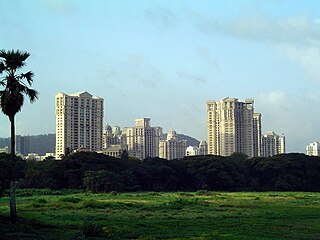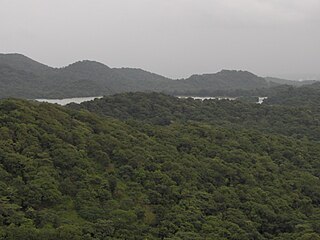
Powai Lake is an artificial lake, situated in Mumbai, in the Powai valley, where a Powai village with a cluster of huts existed. The city suburb called Powai shares its name with the lake. Indian Institute of Technology Bombay, one of the premier institutions of science and technology in India, is located to the east of the lake. Another famous institution, the National Institute of Industrial Engineering (NITIE), is also located close to the lake. Housing complexes and plush hotels are developed all around the lake periphery. Population around the lake has thus substantially increased over the years.
Chembur is an upmarket large suburb in central Mumbai, India. It belongs on the harbour line of suburban railways and offers the best connectivity with Mumbai Monorail, Santacruz- Chembur Link Road, Airport, Jeejamata Bhosle Marg, Eastern Freeway, Eastern Express Highway, BKC connector, and Mumbai Satara highway (Sion-Panvel).

Powai is a residential suburb located in central Mumbai, Maharashtra, India. It is situated on the banks of Powai Lake, and is bound by the hills of Vikhroli Parksite to the south-east, Chandivali to the south-west, the L.B.S. Marg to the north-east and the Sanjay Gandhi National Park to the north beyond the lake. The Jogeshwari-Vikhroli Link Road, one of the city's busiest thoroughfares linking the western and eastern suburbs, passes through Powai. The place also hosts thousands of devotees every year during the Ganesh Chaturthi festival for the visarjan processions.

Mahim (Marathi: माहिम) is a neighbourhood in Mumbai, Maharashtra, India. The Mahim Junction railway station on the Western Railway and Harbour Railway of the Mumbai Suburban Railway network is the last station of the city, as neighboring Bandra comes in Mumbai Suburb. Mahim is an ethnically and religiously diverse town and has a Hindu temple, church, mosque and Parsi fire-temple existing within a few meters of each other. The town has a large Rich and Upper Middle class Marathi population.

Salsette Island is an island in Konkan division of the state of Maharashtra, along India's west coast. Administratively known as Greater Mumbai, the Mumbai Suburban district, Mira Bhayander and a portion of Thane district lie within it, making it very populous and one of the most densely populated islands in the world. It has a population of more than 20 million inhabitants living on an area of about 619 square kilometres (239 sq mi).

Tulsi Lake is a fresh water lake in northern Mumbai. It is stated to be the second largest lake in Mumbai and supplies part of the city's potable water. This is one of the three lakes located in the Salsette Island; the other two being Powai Lake and Vihar Lake. Both Tulsi lake and Vihar lake are located within the densely forested Sanjay Gandhi National Park or also known popularly as the Borivali National Park (BNP).

Vihar Lake is located near Vihar village on the Mithi River within the precincts of the Borivali National Park, also called the Sanjay Gandhi National Park, in North Mumbai. When built in 1860, it was considered as the largest lake in Mumbai in the Salsette group of islands. It is hemmed between the Tulsi Lake and the Powai Lake. It partly meets the drinking water needs of the Mumbai region. It supplies only 3% of the Mumbai city's water requirement, after filtration at Bhandup where the large water filtration plant is located.

Mumbai (Bombay) is India's most populous city with a population of 20 Million. It is located on Salsette Island off the coast of Maharashtra. The original Seven Islands of Bombay were merged by the British in the 18th century, to form one large island.

The Toronto Works and Emergency Services department was responsible for a variety of services.

The Bandra Kurla Complex is a Central business district in the city of Mumbai, India. It is a prominent upscale commercial hub which commands some of the highest property rates in the country. According to MMRDA, the complex is the first of a series of "growth centres" created to "arrest further concentration" of offices and commercial activities in eastern parts of Mumbai. It has aided to decongest the CBD in South Mumbai while seeding new areas of planned commercial real estate in the metropolitan region.

Mumbai Suburban district is the second most populous district of Maharashtra in the Konkan Division. With its administrative headquarters in Bandra, the district consists of three subdivisions or tehsils (townships): Kurla, Andheri, and Borivali. The district along with Mumbai City district and other suburban localities make up Greater Mumbai. The district occupies an area of 446 km2.

Mahim Bay is a picturesque bay situated in the Arabian Sea, along the western coast of India. It is located in the southern part of Mumbai, the capital city of the Indian state of Maharashtra. The bay was named after the islands of Mahim and Salsette were merged in the early 19th century. The Mithi River drains into Mahim Creek which drains into the Bay, and forms the border between the Mumbai city and its Suburbs.

Mahim Creek is a creek in Bombay (Mumbai), India. The Mithi River drains into the creek which drains into the Mahim Bay. The creek forms the boundary between the Bombay City and suburbs. The creek is swamped by mangroves and has a mini-ecosystem within it.
The 2006 Mumbai "sweet" seawater incident was a strange phenomenon during which residents of Mumbai claimed that the water at Mahim Creek had suddenly turned sweet. Within hours, residents of Gujarat claimed that seawater at Tithal beach had turned sweet as well. This caused a mass hysteria among people who started coming in large numbers to drink the sea water.

There are multiple environmental issues in India. Air pollution, water pollution, garbage, domestically prohibited goods and pollution of the natural environment are all challenges for India. Nature is also causing some drastic effects on India. The situation was worse between 1947 through 1995. According to data collected and environmental assessments studied by World Bank experts, between 1995 through 2010, India has made some of the fastest progress in addressing its environmental issues and improving its environmental quality in the world. However, pollution still remains a major challenge and opportunity for the country.

Sion is a railway station on the Central line of the Mumbai Suburban Railway network, located in the Mumbai neighborhood of Sion.

East Mumbai consists the localities of Kurla, Vidyavihar Ghatkopar, Kanjurmarg, Kurla, Mulund, Nahur, Powai, Chandivali and Vikhroli. To the south-east lie the neighborhoods of Chembur, Govandi, Mankhurd, and Trombay.

The Jogeshwari–Vikhroli Link Road (JVLR), is a 10.6-kilometre-long (6.6 mi) 6-lane road with a central median in Mumbai which connects the Western Express Highway and Eastern Express Highway providing speedier access from Jogeshwari in the Western Suburbs to Vikhroli in the Eastern Suburbs. It was opened to traffic in 1994, and widened from two to six lanes in 2012 at a cost of ₹221.45 crore. The under-construction Line 6 of the Mumbai Metro is being constructed on this link road.


















